
How Much Does a Hot Tub Cost?
2024-04-03 15:30For those seeking a comfortable bathing experience at home, selecting the right spa hot tub is crucial. However, price often becomes a significant consideration during the purchasing process. In this article, we will delve into the price range of hot water tubs and related purchasing and operating costs to provide you with a comprehensive understanding of the costs and investments associated with hot tubs.
Table of Contents
Chapter 1: How Much Does a Hot Tub Cost?
Chapter 2: How to Purchase a Hot Tub?
Chapter 3: How to Choose a Hot Tub?
Chapter 4: How to Install a Hot Tub?
Chapter 5: How Much Does it Cost to Install a Hot Tub?
Chapter 6: How Many Kilowatts Does a Hot Tub Use?
Chapter 7: How Much Water Does a Hot Tub Use?
Chapter 8: How Much Does a Hot Tub Increase Your Electric Bill?
This article is divided into 8 chapters, starting from Chapter 1, which analyzes the price range of hot tubs, then moving on to guide you on how to purchase and select a hot tub that suits your needs. It then progresses to instructing you on the steps, precautions, and costs involved in installing a hot tub. Finally, it helps you analyze the subsequent costs of owning a hot tub, such as water and electricity bills. (The rated power and frequency of use are the primary factors affecting the electricity bill of a hot tub.)
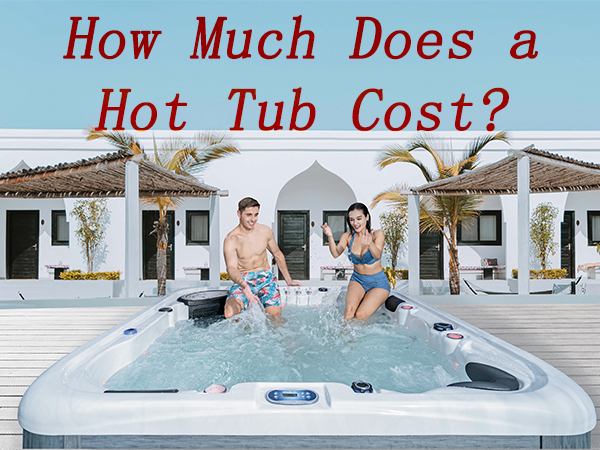
First, let’s break down the price range of spa hot tubs and explore the factors that influence their price.
How Much Does a Hot Tub Cost?
According to the "2023 Global Hot Tub Market Research Report," the price of a hot tub ranges from $2,000 to $30,000. Entry-level hot tubs are priced around $2,000, while mid to high-quality hot tubs range from $5,000 to $26,000, and luxury hot tubs are priced at $30,000 and above. The specific price depends on factors such as brand, model, size, features and region. In European and American countries, the price of a high-quality hot tub generally ranges from US$5,000 to US$26,000. These prices buy you a high-quality bathtub, often with good insulation, comfortable design, and durable materials. Entry-level hot tubs cost relatively little, around $2,000. Although these entry-level bathtubs are less expensive, they still meet the basic needs and experience of most people. In comparison, luxury models of hot tubs can cost upwards of $30,000! These luxury models are usually equipped with more functions, such as massage functions, sound systems, bubble massage, etc., to provide users with a more luxurious bathing experience.
Table 1 below summarizes the price ranges of hot tubs at five different levels: Low Quality, Entry-Level, Medium Quality, High Quality, and Luxury. By comparing their manufacturing materials, size, type, energy efficiency and features, we can visually understand the changing trend of hot tub selling prices and the weight of various factors in the cost.
Table 1: Five Different Levels of Hot Tub Price Ranges
| Starting Price Range | Manufacturing Materials | Size | Type | Energy Efficiency | Function | |
| Low Quality | Under $1,000 | Plastic/Wooden | 1-2 people | Above ground/inflatable | Inefficient insulation | Basic temperature regulation |
| Entry-Level | Around $2,000 | Steel plate/Acrylic | 2-3 people | Above ground/portable | Standard insulation | Basic temperature adjustment, massage |
| Medium Quality | Around $5,000 to $12,000 | Cast iron/Acrylic | 3-5 people | Underground/salt water | Efficient thermal insulation | Spa massage, automation, customization |
| High Quality | $15,000 and above | Ceramic/Acrylic | 5-8 people | Jet type/fixed type | Efficient thermal insulation | Advanced hydromassage, automation, customization |
| Luxury | $30,000 and above | Ceramic/Artificial Stone | 8-12 people | Jet type/fixed type | Highly efficient insulation | Advanced hydromassage, automation, customization |
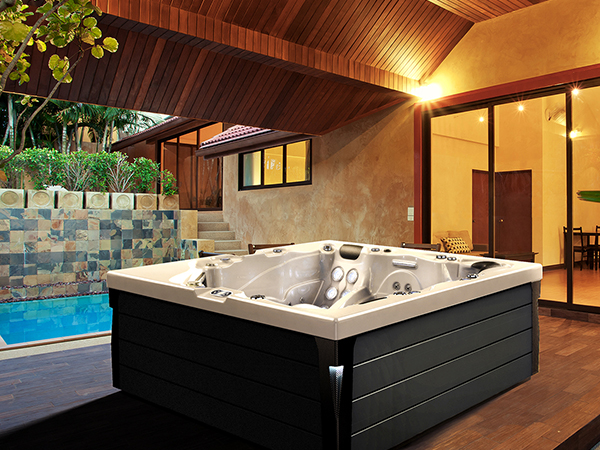
Luxury Hot Tub ($30,000 and above)
Through Table 1, we find that Luxury hot tubs use expensive materials such as ceramics and artificial stone. At the same time, it has more capacity, lower energy consumption and more comprehensive functionality. Luxury hot tubs allow users to experience the highest level of massage and hydrotherapy effects, with customized functions and designs meeting the individual needs of users. Because of the use of the most high-end materials and craftsmanship, the appearance and texture of the Luxury hot tub have also reached the top level, allowing users to experience the ultimate luxury.
Luxury Hot Tub Configuration:
●Customized functions: Unique functions and designs can be customized according to customer needs.
●Advanced massage and spa functions: Provide the highest level of massage experience and spa effects, which may include customized massage programs and spa programs.
●Perfect automated control: The highest level of intelligence, allowing for more automated adjustments and personalized settings.
●Luxury accessories and design: The highest-grade materials and designs may be used, such as gold plating, Italian marble decoration, etc. to create an atmosphere of ultimate luxury.
Low Quality and Entry-Level Hot Tubs ($1,000 to $2,000)
On the contrary, Low Quality (Under $1,000) and Entry-Level (Around $2,000) hot tubs lack many functions and experiences. They are made from cheap materials and consume more energy. With these models of hot tubs, users may experience relatively stable heating effects and temperature control, but functionality and experience are still limited, and temperature fluctuations may sometimes occur. At the same time, the look and feel of Low Quality and Entry-Level hot tubs may be unsatisfactory and may contain some simple design and manufacturing defects.
Low Quality Hot Tub Configuration:
●Basic functions: Provides basic heating functions, simple temperature adjustment, and may not have a massage function.
●Materials and build quality may be lower, resulting in poor durability and insulation.
●May lack additional features such as lighting, audio, etc.
Entry-Level Hot Tub Configuration:
●Basic features: Similar to inferior hot tubs, but may provide more consistent heating and more reliable temperature control.
●Basic massage function: May be equipped with a simple massage jet or bubble system.
●Materials and build quality are relatively improved, but may still not be durable enough.
Medium Quality and High Quality Hot Tubs ($5,000 to $26,000)
The functions and experience of Medium Quality (around $5,000 to $12,000) and High Quality ($15,000 and above) hot tubs are between Luxury and Entry-Level. Its heating effect is more stable than the entry-level model, and the temperature control is more precise. Users can enjoy a higher level of massage and spa experience in the Premium hot tub. The automated control functions are also more intelligent and the user experience is more personalized. The appearance and texture of Premium hot tubs have also reached a certain level, and may have a more refined and luxurious design, and users will also experience higher quality enjoyment.
Medium Quality Hot Tub Configuration:
●Enhanced functions: In addition to basic functions, more massage functions may be provided, such as multiple massage jet settings, massage seats, etc.
●Automation control: It may have an intelligent control system that can control various functions through a remote control or mobile phone application.
●Improved materials and build quality: Possibly more durable materials, improving insulation and longevity.
●Additional functions: It may be equipped with additional functions such as lighting, audio, and water quality treatment to enhance the user experience.
High Quality Hot Tub Configuration:
●Advanced massage function: Equipped with more and more powerful massage jets to provide a richer massage experience.
●Advanced automated control: It may have a more intelligent control system that can automatically adjust temperature, massage intensity, etc. according to user preferences.
●High-quality materials and manufacturing process: Using high-grade materials and fine manufacturing, it provides better thermal insulation effect and longer service life.
●Luxury features: May include more lighting options, sound systems, spa functions, etc., creating a more luxurious experience.
Global Hot Tub Market Size in 2024
At the same time, the research report also predicts that the global spa hot tub market size will be estimated at US$5.66 billion in 2024. It is expected that its market size will reach US$6.68 billion by 2029, with a compound annual growth rate of 3.36% (2024-2029). Asia Pacific is expected to be the fastest growing region for the market, followed by Europe and North America. Growing urbanization in the region and rising purchasing power of consumers, especially from China and India, are expected to drive growth of the market in this region. One of the key factors driving growth is increased investment in the residential and commercial sectors.
Health Benefits of Hot Tubs
Although the cost of purchasing a hot water tub is relatively high, regularly using a hot water tub for bathing has benefits for our physical health. Some studies have found that immersing oneself in hot water can relieve stress and alleviate symptoms of depression. Furthermore, research indicates that individuals who frequently use hot tubs are less likely to develop cardiovascular diseases. Therefore, if you frequently take hot baths, your heart may be healthier.
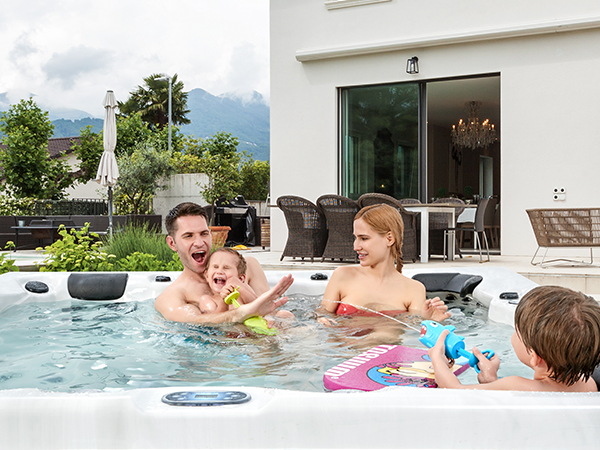
After introducing the prices and functions of these 5 different levels of spa hot tubs, for spa enthusiasts or people who want to buy a hot tub in the near future, how to buy and choose a hot tub that suits your budget and needs? Very important. Below, I will guide you in detail on how to buy and choose a hot tub that suits your budget and needs at the minimum cost to help you enjoy the highest level of spa experience.
How to Purchase a Hot Tub?
3 Steps to Guide You on How to Purchase a Hot Tub
1. Before Purchasing a Hot Tub,Determine Your Needs and Budget.
2. Research Different Types and Features of Hot Tubs within Your Budget.
3. Look for Reliable Brands and Suppliers.
Before purchasing a hot tub, it's important to first determine your needs and budget. Different budgets will affect the models and features of hot bathtubs you can choose from. Then, research different types and features of hot tubs within your budget, considering the location where you intend to place the hot bathtub and selecting the appropriate size and shape. Finally, the most crucial step is to find reliable brands and suppliers. "LOVIA SPA" is the most famous and largest outdoor spa and swim spa manufacturer in China, with a factory covering an area of 45,000 square meters, employing over 20 experts and 200 workers, and achieving an annual turnover of $500 million. All of their products are certified by industry standards such as CE, ETL, SAA, ROHS, REACH, and ISO9001. Their commitment is to provide customers with excellent and valuable outdoor spa solutions.
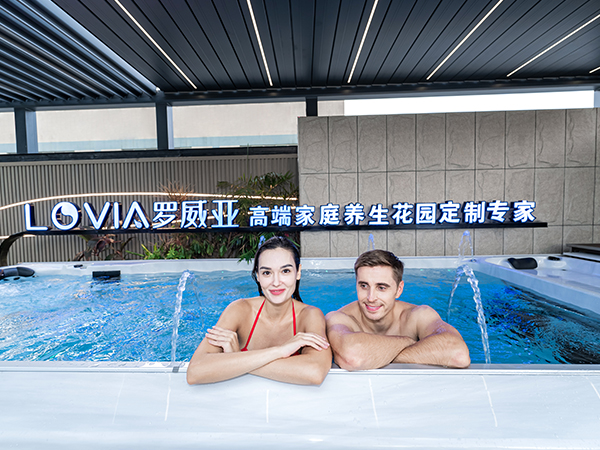
Once you have determined your budget, features, model, and brand for purchasing a spa hot tub, you can then choose a hot tub online or offline. Below I will continue to help you how to choose a hot tub (for 6 materials and 8 functions) and choose a hot tub that you are satisfied with.
How to Choose a Hot Tub?
3 Steps to Teach You How to Choose a Hot Tub
1. Consider Space Requirements.
2. Consider Material Requirements.
3. Consider Functional Requirements.
When choosing a hot tub, it's important to focus on space requirements, materials, functionality, energy efficiency, and aesthetic design. Common materials for hot tubs include acrylic, steel, cast iron, ceramic, wood, and engineered stone. Common features include massage functions, temperature control systems, LED lighting, audio systems, heated seats, self-cleaning systems, and overflow designs.
6 Common Hot Tub Materials:
1. Acrylic: Acrylic is a type of organic glass that effectively retains heat in hot water. Acrylic bathtubs often come in a variety of styles due to their stain resistance and ease of processing, but their surfaces are prone to wear and tear, with a lifespan of approximately 10 years.
2. Steel Plate: Steel plate bathtubs are made from stamped steel plates and coated with enamel. They offer good abrasion resistance, heat resistance, and pressure resistance, but their thin steel plates result in poor insulation.
3. Cast Iron: Cast iron bathtubs are made using a casting process and coated with enamel. They are easy to maintain, produce minimal noise during use, and offer excellent insulation. Due to their thick walls and excellent resistance to acid and alkali, cast iron bathtubs have the longest lifespan and are typically more expensive.
4. Ceramic: Ceramic bathtubs are made by casting ceramics. While they are thick and durable, they are heavy, prone to damage, and relatively difficult to transport and maintain. The smooth surface may cause slipping during use, and scratches are not easily repaired.
5. Wood: Wooden bathtubs, similar to ancient wooden barrels, offer good insulation but are prone to leakage and have a shorter lifespan.
6. Engineered Stone: Engineered stone bathtubs are made by processing various materials and offer good insulation and ease of cleaning, with the added benefit of being lightweight.
Priority of Bathtub Materials: Engineered Stone > Ceramic > Cast Iron > Acrylic > Steel Plate > Wood.
If you only need a simple hot bathtub, acrylic material typically meets the needs of most people. For a slightly better option, you can consider cast iron material. Engineered stone, however, is currently the most high-end bathtub material. If you plan to purchase an engineered stone bathtub, please choose a reputable brand to avoid quality issues caused by unscrupulous merchants, such as the inclusion of materials harmful to human health and the home environment.
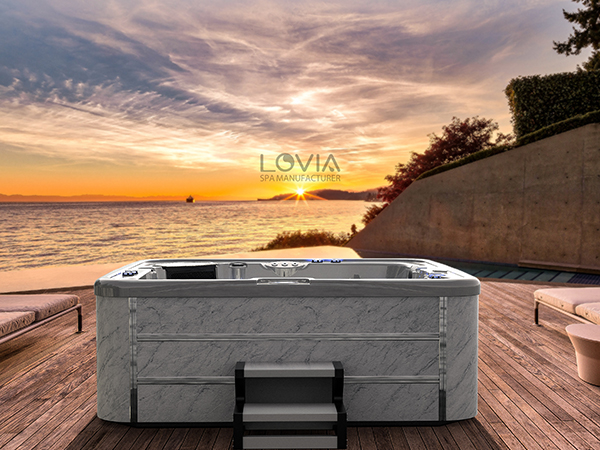
8 Common Hot Tub Features:
1. Massage Functions: Massage functions are divided into water flow massage and bubble massage. Water flow massage provides direct massage action through water jets, targeting different areas for massage. Bubble massage creates a soothing massage effect by generating bubbles through bubble jets, helping to relax the body and alleviate stress.
2. Constant Temperature System: The constant temperature system automatically adjusts the water temperature of the spa hot tub, ensuring a consistent comfortable temperature throughout the bathing process without the need for frequent adjustments.
3. LED Lighting: Built-in LED lighting systems offer various colors and lighting effects, allowing users to choose different lighting modes according to personal preferences and moods, creating a romantic and comfortable atmosphere.
4. Audio System: Built-in audio systems can be connected to music players or smart devices, allowing users to enjoy music or listen to broadcasts while bathing, providing a more enjoyable bathing experience.
5. Heated Seats: Heated seats provide warm and comfortable seating through built-in heating devices, allowing users to enjoy a more comfortable experience while bathing.
6. Self-Cleaning System: The automatic cleaning system periodically cleans the interior of the hot bathtub, including pipes and nozzles, reducing maintenance work and maintaining clean and hygienic water quality.
7. Remote Control: High-end hot bathtubs are equipped with remote controls, allowing users to conveniently control various functions such as adjusting water temperature, massage intensity, and controlling lighting and audio.
8. Overflow Design: The overflow design prevents water overflow in the hot bathtub. When the water level exceeds a certain height, excess water is automatically drained to maintain a constant water level.
If you want to purchase a hot tub that helps burn calories, you can choose a model equipped with a water flow system and massage jets. These features can provide more movement and activity, helping to increase calorie expenditure. Additionally, selecting a hot tub with adjustable water temperature is important because higher water temperatures can promote blood circulation and metabolism, thereby increasing calorie consumption. Finally, you may also consider choosing a larger hot tub to ensure you have enough space for various exercises and activities, such as swimming and aquatic aerobics, to achieve better calorie-burning effects.
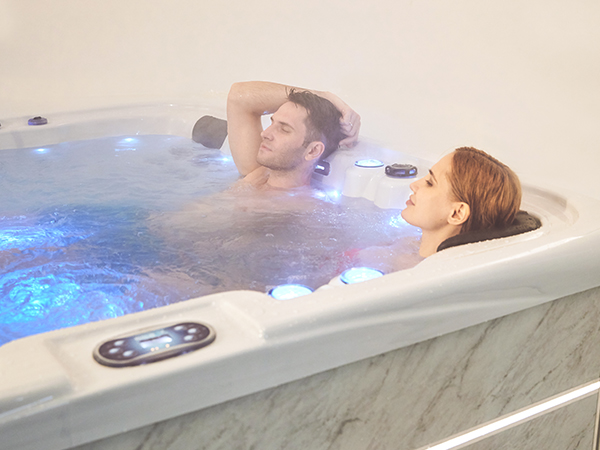
After purchasing your spa hot tub, the next step is to install it. Installation methods are generally divided into two types: self-installation (DIY) and asking a professional installation team to install. Next, I will focus on explaining the main steps and methods of installing a hot tub. Whether you are DIY or hire a professional installation team, I can help you.
How to Install a Hot Tub?
Once you purchase your hot water tub, how to install it is another question. Below I will teach you 2 important points and 7 steps to properly install a hot tub.
2 Important Points to Install a Hot Tub
1. Key Points for Installing Freestanding Bathtubs:
The installation of freestanding bathtubs is relatively simple, but installing the inlet and outlet water pipes is a critical issue. Before installation, it is necessary to prepare or modify the bathtub's water outlets and other pipes in advance. Then, place the hot tub on two wooden blocks, connect the upper and lower water pipes, try filling the bathtub with water, and check if there are any leaks in the drain. If there are no leaks, the basic installation of the hot tub is complete.
2. Key Points for Installing Built-in Bathtubs:
The focus of installing built-in bathtubs lies in waterproofing. The main steps include: first, complete the bathtub's pipeline work, then focus on repairing the grooved areas to ensure waterproofing, and conduct a leak test within one to two days. Next, lay the floor in the normal order; then, use foam bricks to cushion the built-in bathtub, usually not exceeding 60 centimeters in height; finally, leave a 250x300 millimeter inspection hole at the position of the drain pipe.

How to Install a Hot Tub in 7 Steps
1. Choose the Right Size:
For hot tub installation, choosing the right size is a very important aspect, because the size affects the installation location and so on. For example, if the bathroom has a larger space, you will have more freedom when installing a bathtub. But if space is limited, the installation location may be relatively fixed.
2. Handle the Skirt and Bottom Correctly:
The treatment of the skirt and base requires special attention because hot tubs are often installed during the renovation process, rather than waiting until all renovation work is completed. Therefore, depending on the actual size of your hot bathtub, it's best practice to build the skirt and bottom with bricks or cement to a height that just reaches the bottom of the tub.
3. Use Glass Glue Correctly:
When installing a hot tub, there are certain requirements for the use of glass glue. Despite the large size of the bathtub, in order to ensure the stability of the bathtub and extend its service life, it is recommended to apply glass glue where the hot bathtub contacts the skirt and walls. This ensures that the bottom of the tub remains dry and prevents water from intruding, thereby extending its service life.
4. Check the Bathtub Installation Position:
Make sure drainage is appropriate and installed securely. During installation, protect your hot tub and sewer facilities by taking steps to prevent contamination, impact, and blockage. At the same time, be careful not to let sparks from the angle grinder and spot welding machine splash onto the bathtub, so as not to damage the glaze and affect the appearance of the bathtub.
5. Set up Grounding Wire and Leakage Protection Switch:
When installing a hot water tub, a ground wire and a leakage protection switch must be installed. During the installation process, please ensure that after the electrical plug is connected, waterproof measures are taken around the contact pad to avoid leakage accidents. Before connecting the water pipe, be sure to conduct a power test on the motor and listen carefully to see if the sound meets the requirements.
6. Check Whether the Ground is Flat:
Before installing a hot tub with brackets, check that the surface it will be placed on is level. After placing the hot tub in the prepared position, use a spirit level to adjust the support nut until the tub is completely level.
7. Pay Attention to Protecting the Bathtub:
During hot water tub installation and house decoration, you can use soft materials to cover the surface of the tub, but do not build on the tub or place heavy objects on the edge of the tub to avoid damaging the tub. After the hot tub is installed, you need to wait 24 hours before using it.
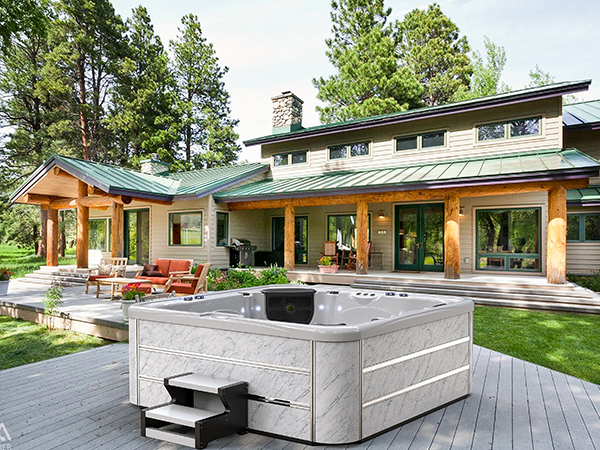
If you plan to hire a professional hot tub installation team, installation costs are unavoidable. Below, I will continue to analyze the costs of installing a spa hot tub for you. We will take Western developed countries as an example. I hope this case information can help you.
How Much Does it Cost to Install a Hot Tub?
The cost to install a hot tub ranges from approximately $1,000 to $1,500, including labor and electrical wiring. In Western developed countries, labor costs are usually higher. Labor costs include moving the hot tub to the desired location, installing plumbing and wiring, and more. The price of crane services ranges from approximately US$700 to US$1,000. This step requires the cooperation of several people to complete, so the cost is higher. Second, electrical wiring costs approximately $300 to $500, depending on the complexity of the electrical work required. Before a hot tub is installed, an electrical engineer is required to perform electrical wiring work to ensure the hot bathtub is safe to use. This includes setting up dedicated circuits, underground piping, and up to 100 feet of wiring while installing 110V/220V GFCI outlets or subpanels near the hot water tub.
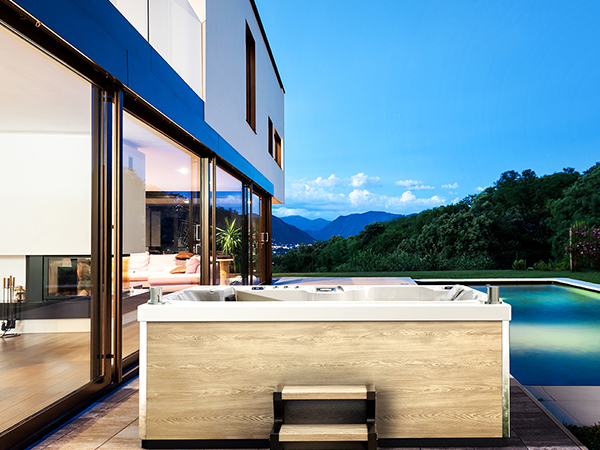
In addition to the cost of purchase and installation, the ongoing utility bills of a spa hot tub are also a significant expense. A few questions that come to mind for many hot tub enthusiasts are, how much electricity does a hot tub consume? How much water to use? Next I’m going to dive into the factors that affect your hot tub utility bill, but first, let’s discuss its power rating.
How Many Kilowatts Does a Hot Tub Use?
The power a hot bathtub uses usually depends on its size, model, and features. Power requirements for hot tubs may vary from country to country, which is often affected by national or regional regulations and standards. In European and American countries, plug and play hot tubs generally have a power range of 1.5 kilowatts to 5.0 kilowatts (1.5KW-5.0KW), while hot tubs with capacity-boosting features have a power of approximately 6.0 kilowatts (6.0KW), and instant hot tubs have a power of around 8.0 kilowatts (8.0KW). The power consumption of a hot tub mainly consists of five components (heater, water pump, massage/bubble system, control panel, lighting system).
The heater is one of the most important components of a hot tub and the most powerful component in the tub. For a 5.0 kW hot tub, the heater power may account for about 3.5 kW. Heaters are usually electric heating tubes or heating rods, which are responsible for converting electrical energy into thermal energy to heat the temperature of the water.
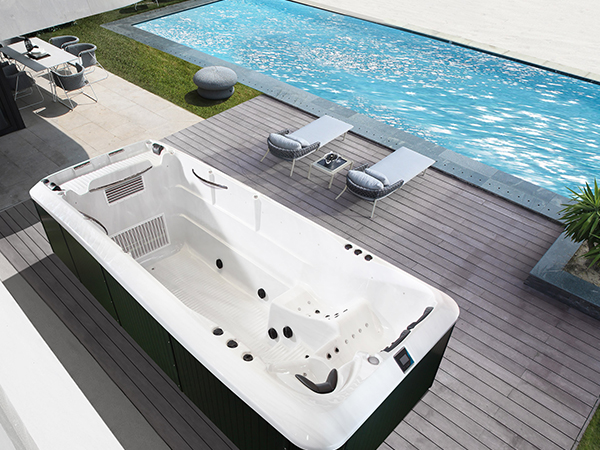
The frequency and duration of use are also the biggest factors directly affecting the water and electricity costs of hot tubs. Next, I will give you an example to analyze the electricity and water consumption of hot tubs per hour and month, as well as the amount of additional electricity bills per month, to help you better use and manage the cost of hot tubs.
How Much Electricity Does a Hot Tub Use?
The electricity consumption of a hot tub mainly depends on its power rating. Generally, the power supply for hot bathtubs is 110V/220V/380V, with power ratings typically ranging from 1500 watts to 5000 watts (1.5KW-5.0KW). In order to give you a more intuitive understanding of the energy consumption of hot tubs, I compiled a data table as shown below (see Table 2).
Hot Tub Electricity Consumption Calculation
Taking a hot tub with a power rating of 1500 watts as an example, the electricity consumption for continuous operation for 1 hour is 1.5 kWh. For a hot tub with a power rating of 5000 watts, the electricity consumption for continuous operation for 1 hour is 5.0 kWh. Therefore, the electricity consumption of hot tubs on the market typically ranges from 1.5 kWh to 5.0 kWh per hour. If operated for 20 hours a month, the total power consumption of a 1500-watt hot tub is 30 kWh, and the total power consumption of a 5000-watt hot tub is 100 kWh. Of course, individual usage habits, including differences in water temperature and equipment losses, may lead to variations in actual electricity consumption. Larger or more luxurious hot water tubs may have higher power requirements and therefore higher electricity consumption.
Table 2: Hot Tub Electricity Consumption Calculation
| Hot Tub Rated Power | Usage Time/Day | Power Consumption/Day | Usage Time/Month | Power Consumption/Month |
| 1500W | 1 Hour | 1.5KWh | 20 Hours | 30KWh |
| 5000W | 1 Hour | 5.0KWh | 20 Hours | 100KWh |
How Much Water Does a Hot Tub Use?
Spa hot tubs for adults typically hold 300 to 450 gallons of water. However, showering is usually required before and after using a hot bathtub. Men need 10 to 15 gallons of water to shower, while women need 15 to 20 gallons. Therefore, the total water consumption of a hot tub in one use is approximately between 310 and 470 gallons. If used during the summer, more water may be needed. The specific amount of water consumed will also be affected by many factors such as the size of the bathtub, personal water usage habits, faucet flow, etc.
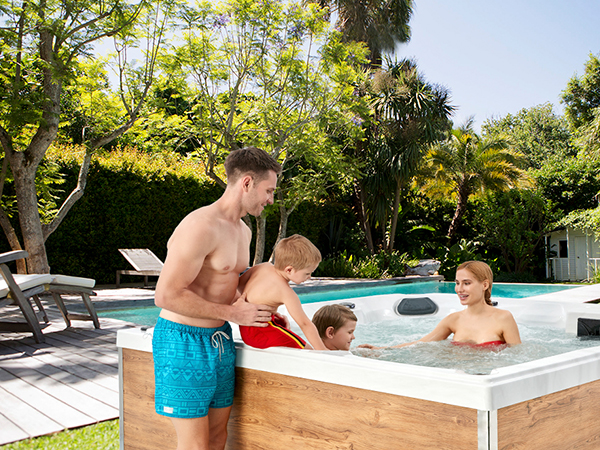
How Much Does a Hot Tub Increase Your Electric Bill?
The cost of electricity for a hot water tub depends on its power, frequency of use and how long it is used. According to the electric energy conversion formula: electric energy = power * time. Assume that the power of the hot tub is 4000 watts (4.0KW) and the use time is 1 hour, the power consumption is 4.0 kilowatt hours (kWh), and the use time is 2 hours, the power consumption is 8.0 kilowatt hours (kWh). In the United States, electricity costs approximately $0.10 to $0.30 per kilowatt hour. In some European countries, electricity costs may be as high as between 0.15 and 0.30 euros per kilowatt hour. In order to give you a more intuitive understanding of the monthly electricity bill for a hot tub, I compiled a data table as shown below (see Table 3).
Hot Tub Electricity Bill Calculation
We found that if you use your hot tub 30 times a month for 1-2 hours each time, the total energy consumption is somewhere between 120 kWh and 240 kWh. So, your monthly hot tub electricity bill will be approximately between $24 and $48, or between €27 and €54. In winter, this fee may be higher. At the same time, the age of the device will also affect power consumption. Only by properly using and maintaining your hot tub can you minimize your energy bills.
Table 3: Hot Tub Electricity Bill Calculation
| Hot Tub Rated Power | Use Time | Power Consumption/1 Time | Month/Power Consumption (30 Times) | Electricity cost per Kwh (USA) | Electricity Bill/Month | Electricity cost per kWh (Europe) | Electricity Bill/Month |
| 4000W | 1 Hour | 4.0Kwh | 120Kwh | $0.2 (Average) | $24 | €0.225 (Average) | €27 |
| 4000W | 2 Hours | 8.0Kwh | 240Kwh | $0.2 (Average) | $48 | €0.225 (Average) | €54 |
The above is the entire content of our news. We hope that this content can help you choose a spa hot tub that is satisfactory and fits your budget, and help you save money on utility bills to the greatest extent. If you want to know more about the parameters of hot tubs, please click the link below to visit the products on our official website. Thank you for reading our content and we wish you the best in choosing a hot tub!
